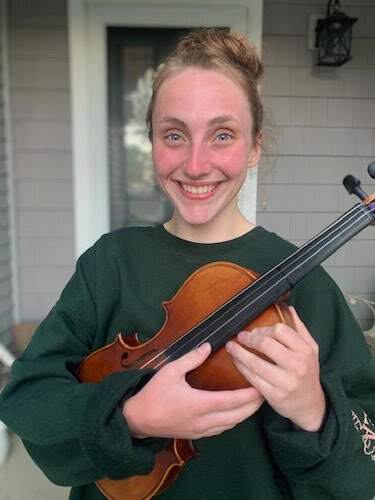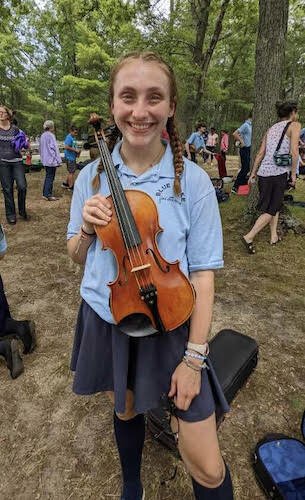BCreative gives Battle Creek students the opportunities to be creative
In the 10 years since BCreative was first established, more than $1 million has been awarded by the the Miller Foundation to Battle Creek area individual students and schools.
Editor’s note: This story is part of Southwest Michigan Second Wave’s On the Ground Battle Creek series.
Laine Decker credits a grant and scholarship program offered by the Miller Foundation with giving her the opportunity to audition for and secure a spot as a violinist with the Kalamazoo Junior Symphony Orchestra.
Laine, 17, a junior at Lakeview High School, is one of more than 20,000 students in Battle Creek area schools who have benefited from BCreative, an arts-focused grant and scholarship program funded by the Miller Foundation. In the 10 years since it was first established, more than $1 million has been awarded to individual students and schools, says Sara Wallace, President and CEO of the Miller Foundation.
“To date, we have served 1,972 students with scholarships and have given out 172 field trip grants,” Wallace says.
Laine, who began playing the violin with a school orchestra in 6th grade, received her first scholarship for $800 in 2018 to attend Blue Lake Fine Arts Camp. That scholarship covered half the cost of attending Blue Lake. She has continued to receive those scholarships every year since and has used other funding sources, including her parents’ to make up the difference.
Without these scholarships, she says, “I wouldn’t have been able to go. The scholarships permitted me to go to these camps. It’s been such a blessing and I have really been able to grow with my instrument. I’ve grown in many different ways. I became a lot more confident in myself through my instrument and it’s allowed me to keep growing.”

Being at Blue Lake, she says, has also allowed her to make friends with youth throughout the Midwest who attend the music arts camp and given her the confidence to become a leader in her high school’s orchestra.
“It’s given me the tools to grow and help others,” says Laine, who would like to pursue a career in Music Therapy.
Wallace says providing access to these experiences and opportunities for area youth is one of the reasons BCreative was established.
“BCreative started when our board of trustees noticed that arts, creative learning, and that kind of focus was leaving the schools,” Wallace says. “There’s not a lot of extra money in the schools and arts funding was being cut. We thought this would be a way to help teachers plan fun activities as a way to aid in their students’ learning.”
Among the more recent field trips was one that involved second-graders from Wattles Park Elementary School who visited Historic Charlton Park Village, Museum and Recreation Area in Hastings as part of their history lessons. Wallace says they learned how to make soup, churn butter, and learned how people of the late 1800s to early 1900s lived and earned money.
“A couple of years ago we had a school group that went to ArtPrize in Grand Rapids,” she says. “This was an opportunity to show them some amazing works of art.”
A field trip grant has covered the cost to take students from Riverside Elementary School to annual free school concerts performed by the Battle Creek Symphony Orchestra, says Paula Carr, a K-4 Music Teacher at Riverside.
“It is an amazing opportunity and we are lucky that we get to go,” she says.
Students at Riverside also have attended a concert performed by the Brass Band of Battle Creek.
“A group of teachers in my school applied and took the school to see the Brass Band of Battle Creek,” Carr says.
Wallace says the Music Center also has hosted field trips for students. She says field trips which used to be available to students in grades K-12 are now available to classrooms with 3-year-olds and pre-school age children. This interaction “exposes children to music development, movement, dance and the opportunity to play instruments,” she says.
With a focus on teaching to test, Wallace says the types of field trips and scholarships through BCreative provide teachers with different tools to engage students in creative learning.
Field trips can be anywhere in the state of Michigan.
“If a teacher can find a way to work it into their curriculum, we are supportive of that,” Wallace says. “Sometimes we get arts teachers, but it can be any teacher.”
BCreative field trip grants pay up to $500 per classroom. Wallace says often educators will plan a trip with other educators and students and can end up with $2,000 by pooling the grant funds.
“There is no cap,” she says. “Technically, someone could choose to take an entire school.”
On the scholarship side, students have received anywhere from $50 to $3,000 to cover half of the cost of whatever arts-based program they are participating in.
“We just really have appreciated how much the foundation and BCreative has allowed her to grow each summer and for her to be able to go multiple years,” says Jennifer Decker, Laine’s mother. “Blue Lake is not cheap. To be able to have that scholarship to pay for half of the camp has allowed her to develop confidence in her musical skills. I appreciate that they have invested in youth in the arts in this community. Hopefully, someday (Laine) will be part of the Battle Creek Symphony Orchestra or another community group.”
Wallace says by design scholarships are not needs-based.
“Our board wanted the arts to be available across all sectors but felt very adamant that they didn’t want kids to have to talk about deficits,” she says. “As long as you live in the Battle Creek area and go to Battle Creek schools, public or private, you are eligible. They can go to any organization in the state, but it does have to be a nonprofit.”
BCreative funding isn’t limited to music or art camps and includes everything creative from painting to writing to singing to computer design, even programming, architecture, and other specialized programs that further develop the student’s creative talents, according to information on the Miller Foundation’s website.
Laine says BCreative is supporting young people like her who have an interest in the arts and need additional support that isn’t available in schools.
“If you don’t fund the arts, kids don’t have an outlet for that creative part of themselves,” she says.















